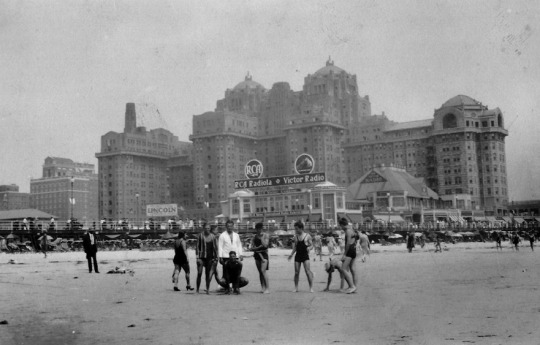#Traymore Hotel demolition
Text
Traymore Hotel - The Art Deco skyscraper by the Sea in Atlantic City
Traymore Hotel – The Art Deco skyscraper by the Sea in Atlantic City
The resort begun as a small boarding house in 1879, the hotel expanded and became one of the city’s premier resorts. As Atlantic City began to decline in its popularity as a resort town, during the 1950s and 1960s, the Traymore diminished in popularity. By the early 1970s the hotel was abandoned and severely run down. It was imploded and demolished in 1972. Most of the Traymore site remains a…

View On WordPress
0 notes
Photo








Man’s Impact on the Environment
Marlborough-Blenheim Hotel
Atlantic City, New Jersey
The Marlborough-Blenheim Hotel was a historic resort hotel property in Atlantic City, New Jersey, built in 1902-1906, and demolished in October 1978.
In 1900, Josiah White III bought a parcel of land between Ohio Avenue and Park Place on the Boardwalk, and built the Queen Anne style Marlborough House. The hotel was financially successful and, in 1905, he chose to expand. White hired Philadelphia architect Will Price of Price and McLanahan to design a new, separate tower to be called the Blenheim. "Blenheim" refers to Blenheim Palace in England, the ancestral home of Sir Winston Churchill, a grandson of the Duke of Marlborough.
Recent hotel fires in and around Atlantic City, Price's recent experience of designing the all-concrete Jacob Reed store in Philadelphia, and a steel strike in the fall of 1905 influenced Price's choice of reinforced concrete for the tower. It opened in 1906.
It was not the first reinforced concrete hotel in the world, as French concrete pioneer François Hennebique had designed the Imperial Palace Hotel in Nice five years previously. But it was the largest reinforced concrete building in the world.[6] The hotel's Spanish and Moorish themes, capped off with its signature dome and chimneys, represented a step forward from other hotels that had a classically designed influence.
In 1916, Winston Churchill was a guest of the hotel.
In 1977 Reese Palley and local attorney and businessman Martin Blatt bought the Marlborough-Blenheim and planned to preserve the Blenheim half of the hotel, along with adjacent Dennis Hotel for his Park Place Casino. Palley was successful in getting the Blenheim part of the hotel placed on the National Register of Historic Buildings, while planning to raze the Marlborough to make way for a new modern hotel. Ten days later, he stepped aside when Bally Manufacturing purchased a controlling interest in the project.[8] After Bally took control, they announced plans to raze the Marlborough-Blenheim and the adjacent Dennis Hotel, despite protests, to make way for the new "Bally's Park Place Casino and Hotel". However, in an effort to offset costs and get the casino opened as fast as they could they chose to keep the Dennis Hotel, which would serve as the temporary hotel for Bally's until a new tower was built.
Bally demolished the wood-framed Marlborough with the conventional wrecking ball. For the Blenheim the company hired Controlled Demolition, Inc. (CDI) and Winzinger Incorporated of Hainesport New Jersey, which had taken down the Traymore Hotel, to implode the structure. A preservation group which had sought historic status for the building won a stay of execution for the Blenheim's rotunda portion on the Boardwalk. It was separated from the rest of the hotel, which was imploded in the fall of 1978. Several months later its historic status was denied, the stay was lifted, and CDI finished the demolition January 4, 1979. It is not known if they sold the name Marlborough-Blenheim as well.
Bally's Park Place now stands at this location.
0 notes